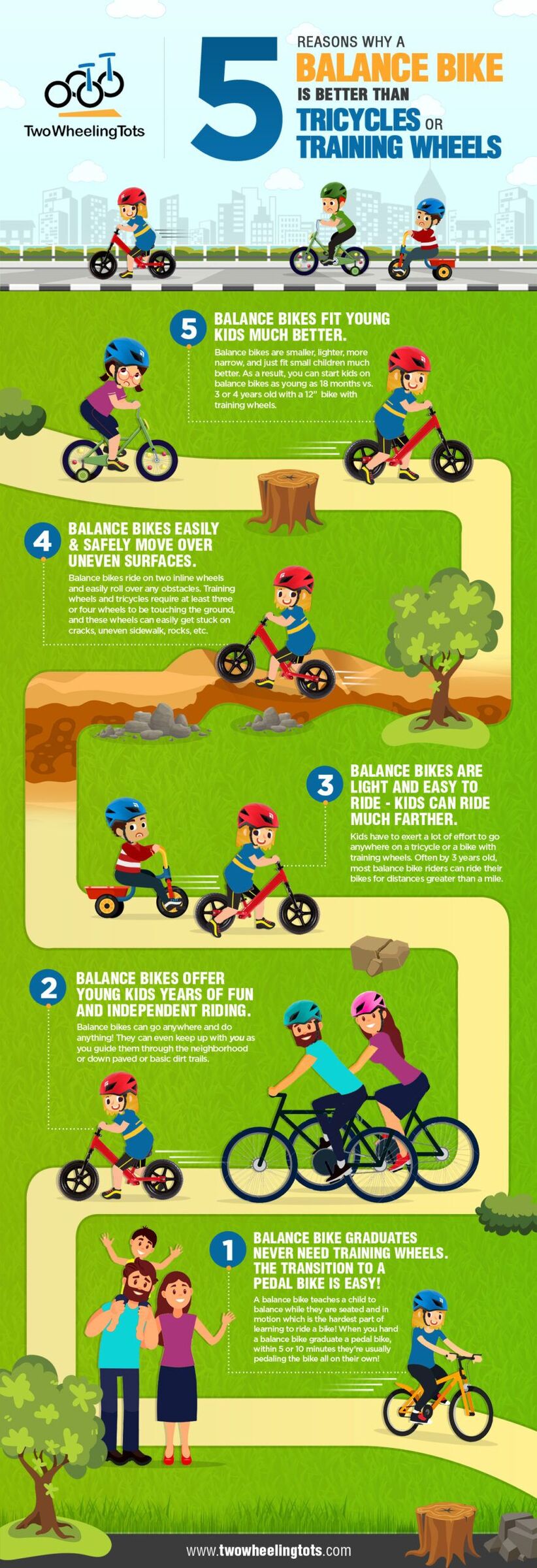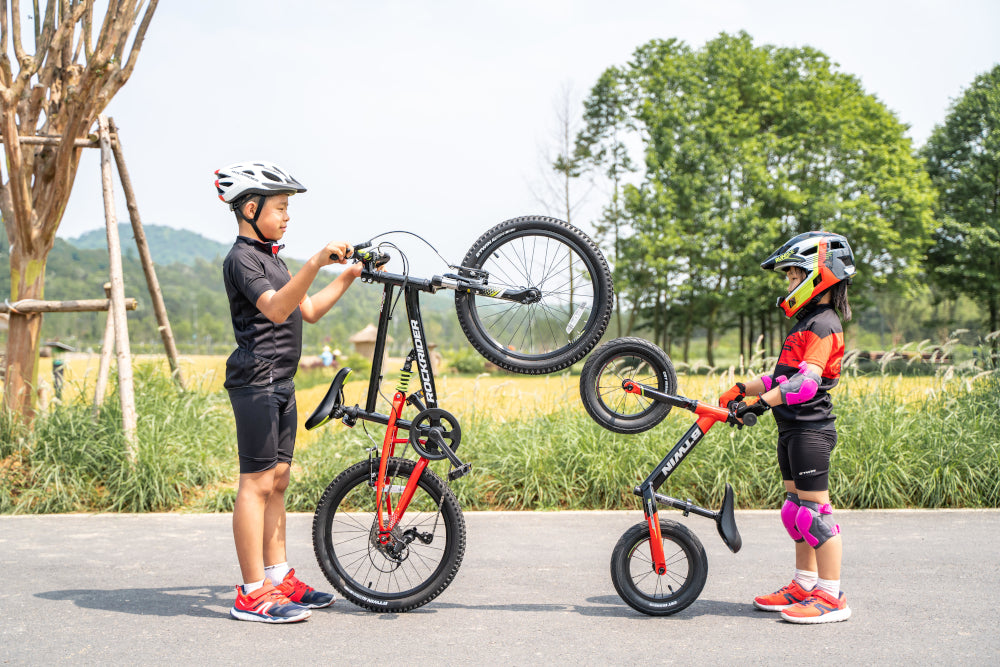Choosing between a balance bike and a tricycle can be tricky. Both are popular options for young children learning to ride.
Each offers unique benefits and experiences. Understanding balance bike vs tricycle is important for making the best choice for your child. Balance bikes help children develop coordination and balance skills. Tricycles offer stability and are often seen as a more traditional option.
This comparison will guide you through the pros and cons of each. By the end, you will have a clear idea of which option suits your child’s needs better. Let’s explore what makes each one special and how they can benefit your little rider.
Table of Contents
Balance Bike Basics
Curious about balance bikes? They’re a popular choice for young kids. Balance bikes teach children how to balance and steer. They skip the pedals found on traditional bikes. This makes them easier for kids to manage.
What Is A Balance Bike?
A balance bike is a simple, pedal-free bike. Kids use their feet to push and glide. This helps them focus on balancing. It’s perfect for toddlers and preschoolers.
Balance bikes are low to the ground. This makes it easy for kids to reach the ground. They feel more secure and confident.
Key Features
Balance bikes come with adjustable seats. This means the bike grows with your child. Some have air-filled tires. These offer a smoother ride. Others have foam tires. These need less maintenance.
Balance bikes are lightweight. Kids can easily lift and carry them. They have a simple design. This reduces the risk of injury. Most balance bikes have a footrest. Kids can place their feet here when they glide.
Tricycle Basics
Tricycles are a popular choice for young children learning to ride. They have been around for decades and offer a stable and safe introduction to cycling. Understanding the basics of tricycles can help parents make an informed decision for their kids.
What Is A Tricycle?
A tricycle is a three-wheeled vehicle designed for young children. It typically has one large front wheel and two smaller rear wheels. This design provides stability and balance, making it easier for toddlers to ride.
Key Features
Tricycles come with various features that make them suitable for young riders. Here are some key features to consider:
- Three wheels: Provides extra stability and balance.
- Low center of gravity: Makes it harder to tip over.
- Pedals: Usually located on the front wheel, helping kids learn to pedal.
- Handlebars: Easy to grip, allowing children to steer with confidence.
- Adjustable seats: Some tricycles have seats that can be adjusted as the child grows.
These features make tricycles a great choice for toddlers who are just starting to explore the world of riding. Parents can feel confident knowing their child is on a stable and safe vehicle.
Benefits Of Balance Bikes
Balance bikes have gained popularity among parents and children. They offer many benefits over traditional tricycles. These bikes help children learn balance and coordination. Let’s explore the key benefits of balance bikes.
Developing Balance
Balance bikes are specifically designed to help children develop balance. They allow kids to focus on balancing without the distraction of pedals. Children learn to balance naturally as they glide along. This skill is crucial for riding a regular bike later. Learning to balance at an early age builds confidence. It also improves coordination and motor skills.
Ease Of Transition To Pedal Bikes
One of the main advantages of balance bikes is the ease of transition to pedal bikes. Kids who start with balance bikes find it easier to switch to pedal bikes. They already know how to balance and steer. They only need to learn to pedal. This makes the transition smooth and less intimidating. Balance bikes eliminate the need for training wheels. This helps children gain independence faster.
Here is a table comparing the benefits of balance bikes and tricycles:
| Aspect | Balance Bike | Tricycle |
|---|---|---|
| Balance Development | Yes | No |
| Ease of Transition | High | Low |
| Training Wheels Needed | No | Yes |
Balance bikes offer a fun and effective way to teach kids to ride. They build essential skills like balance and coordination. They also make the transition to pedal bikes easier and faster.
Benefits Of Tricycles
Choosing the right ride for your child can be challenging. Understanding the benefits of tricycles helps make the decision easier. Tricycles offer many advantages that parents and kids appreciate. These benefits range from stability and safety to encouraging physical activity.
Stability And Safety
Tricycles have a stable design. They have three wheels, which make them less likely to tip over. This stability gives parents peace of mind. Kids feel secure and confident while riding. The low center of gravity adds to the safety. Tricycles are often made with sturdy materials. This durability ensures a safe ride for children.
Physical Activity
Riding a tricycle keeps kids active. It encourages them to move their legs and use their muscles. Pedaling helps build strength and coordination. Physical activity is important for healthy growth. Tricycles also get kids outside. Fresh air and sunshine benefit their overall well-being.
Considerations For Balance Bikes
Choosing the right bike for a child is crucial. Balance bikes offer many benefits. This section discover the key considerations when selecting a balance bike.
Age And Readiness
Balance bikes are best for children aged 18 months to 5 years. They help kids learn balance and coordination early. Younger children can start with a bike that has an adjustable seat. This ensures the bike grows with them. Older kids may prefer larger models. Check the child’s readiness. Can they walk steadily? If yes, they are likely ready for a balance bike.
Cost And Durability
Balance bikes come in various price ranges. Some are affordable, while others are more expensive. Consider the bike’s material. Metal bikes are sturdy and durable. Wooden bikes are lighter but may wear faster. Plastic models are lightweight but less durable. Think about your budget. Investing in a durable bike can save money in the long run. Look for features like air-filled tires. They offer a smoother ride and last longer.

Credit: www.mystylelabel.com
Considerations For Tricycles
When deciding between a balance bike and a tricycle, it’s important to consider various aspects. Tricycles can be a great option for young children, but they come with their own set of considerations. Below, we explore some key factors to think about when choosing a tricycle for your child.
Age And Readiness
Age and readiness are crucial when considering a tricycle. Most tricycles are designed for children aged 2 to 5 years. At this age, kids are developing their coordination and motor skills. A tricycle can help them build confidence and balance. However, it’s essential to ensure your child is physically ready for this type of ride. Look for signs like walking steadily and the ability to follow simple instructions.
Space And Storage
Space and storage are important practical considerations. Tricycles can be bulky and may take up more space than balance bikes. If you have limited storage, think about where you will keep the tricycle. Some tricycles come with foldable options, making storage easier. Check the dimensions before buying to ensure it fits your available space.
| Consideration | Details |
|---|---|
| Age and Readiness | Best for children aged 2-5 years. Ensure child’s physical readiness. |
| Space and Storage | Can be bulky. Consider foldable options and check dimensions. |
When choosing a tricycle, always prioritize safety. Make sure it has a sturdy build and reliable brakes. With the right considerations, a tricycle can be a wonderful addition to your child’s growth and playtime.
Making The Right Choice
Choosing between a balance bike and a tricycle can be tough. Both have their benefits. But the best choice depends on your child’s needs. This section will help you decide.
Child’s Personality And Preferences
Every child is unique. Some kids love adventure and speed. They might enjoy a balance bike more. It lets them glide and feel the wind. Others prefer stability. They may feel safer on a tricycle.
Observe your child. Do they like to challenge themselves? Or do they prefer a steady pace? Their personality will guide your choice. Pay attention to what makes them smile. That is a big clue.
Long-term Goals
Think about the future. A balance bike helps with balance and coordination. It prepares kids for a regular bike. They learn to steer and control their movements. This can make the transition to a pedal bike easier.
A tricycle is more stable. It is good for building leg strength. Kids can pedal and enjoy the ride. This can be a good start for children needing stability. But it may take longer to learn balance.
Weigh your goals. Decide what skills you want your child to develop. This will help you make the right choice.

Credit: www.decathlon.com

Credit: bikeclub.com
Frequently Asked Questions
What Is A Balance Bike?
A balance bike is a pedal-less bike designed to teach children balance. It helps them transition to a regular bike without training wheels.
Is A Tricycle Better Than A Balance Bike?
A tricycle offers stability but doesn’t teach balance. Balance bikes help kids learn balance and coordination, preparing them for a regular bike.
At What Age Can A Child Use A Balance Bike?
Children can start using a balance bike as early as 18 months. It depends on their physical development and coordination.
Are Balance Bikes Safer Than Tricycles?
Balance bikes are generally safer as they prevent tipping over. They allow children to put their feet on the ground quickly.
Conclusion
Choosing between a balance bike and a tricycle can be tough. Both options offer unique benefits for kids. Balance bikes help develop coordination and balance. Tricycles provide stability and can be easier for beginners. Think about your child’s needs and preferences.
Consider their age and physical skills. Either choice can bring joy and fun to your child. Ultimately, the best choice depends on what suits your child best. Happy riding!

